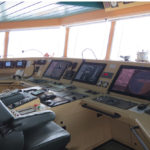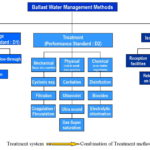No ship can do without ballast water. However, the 10 to 12 billion tonnes of ballast water moving over the oceans each year include a host of »unwanted passengers« which can cause appreciable damage to foreign ecosystems.
Between 1989 and 2000 alone, these hostile organisms caused as much as one billion USD of damage. The IMO has[ds_preview] been working on this problem for more than a decade, culminating in the adoption of the Ballast Water Management Convention (IBWMC) in 2004. The IBWMC aims to reduce the number of micro-organisms imported into the ecosystems through seaborne traffic. The IBWMC will enter into force twelve months after ratification by 30 States, representing 35 % of the world merchant shipping tonnage. As of September 2010, 27 States, representing 25.32 % of world GT have already done so. With only three more states necessary for full ratification, the time to get your ships ready for full compliance with the IBWMC is approaching soon.
One of the most important aspects of the convention is that the ships are to be equipped with technology, such as treatment plants, to make ballast water exchange unnecessary. Another element of the convention is that over a transitional period until the required technology is installed on the ships, the shipmaster is only to perform the ballast water exchange in certain zones on the high seas. Exchange of ballast at sea, as recommended by the IMO guidelines, currently provides the best-available measure to reduce the risk of transfer of harmful aquatic organisms, but is subject to serious ship-safety limits. Even when it can be fully implemented, this technique is less than 100 % effective in removing organisms from ballast water. It is therefore important that the exchange of ballast water at sea is replaced by an effective ballast water treatment methods which are safe for the crew and vessel, environmentally acceptable, cost-effective and technically feasible and practicable. A variety of ballast water treatment systems are underway today, the development of which is based on technologies or procedures currently used for industrial and drinking water treatment. Treatment systems have to undergo a demanding type testing procedure by a Flag state administration in association with classification societies to prove compliance with the required biological standard and safety issues.
There are about forty ballast water treatment manufacturers in the market right now, and about ten systems with full certification approval. The majority of manufacturers have designed their systems in modules to serve retrofitting requirements in narrow engine rooms as well as to cope with the need to treat high volumes when systems can run in parallel assembly.
In this regard, classification societies provide consulting services to owners and shipyards on spare space and additional power supply in the engine room in order to accommodate a possible retrofit of ballast water treatment systems.
Owners therefore face a complex task in choosing and installing the appropriate treatment systems especially when they have no past experience to rely on. Price, of course, is also a concern. Installation costs may go up when engineering services are in high demand and when charterers demand the treatment systems.
Newbuildings as well as existing ships need to choose the right ballast water management system tailored to fit their individual case. The intended range of trade is also important, for example, even if a vessel is not initially intended to sail to the U.S. it might still have to comply with the U.S.’s proposed stricter ballast water standards which could affect spot trading and resale price.
In the course of the future ballast water treatment, expenses will be incurred for both the initial procurement of the system and for the treatment taking place on board.
Statements from the GL’s ballast water expert Christoph Peickert: »We therefore advise our customers planning any newbuildings to provide the necessary technical prerequisites, so that the ships will comply with the requirements of the IMO convention regarding ballast water management. Retrofitting is always the more expensive option. However, ballast water treatment systems are not a one-size-fits-all solution. Choosing the correct ballast water treatment system is a difficult process. Shipowners need to rely on someone with significant engineering experience in ballast water management to determine the best system for them.«
Ballast water treatment processes
Ballast water treatment technical solutions are possible by means of mechanical, physical, chemical or biological processes, either singularly or in combination. The figure below shows the size of harmful aquatic organisms covered by some of treatment methods that will be discussed hereafter.
Filtration
Filtration could achieve the particle removal set out by the 2004 International Convention for the Control and Management of Ships’ Ballast Water and Sediments (50 microns) over a range of capacities. Achieving filtration to a smaller particulate size would have a serious impact on flow rate and back pressure. A filtration step appears to be necessary for most treatment system to remove large organisms present in the intake water and ensures a minimum but still sufficient residual biocide or oxidant concentration and to decrease the sediment load. Sediment can settle in ballast tanks and create a breeding ground for microorganisms and this can lead to microbiologically induced corrosion. Filtration therefore reduces the cost of removing sediment from the ballast tanks and the cost related to the disposal of sediment in an environmentally friendly manner as sedi-ment may now be deemed to be a hazardous waste.
Permanent ballast resulting from sediment reduces the DWT available for cargo carriage. This may seem insignificant for a large ocean-going ship, but in the case of a coaster or inland trading vessel it might be considerable. In addition, using systems that prevent sediment build-up could result in fuel saving.
A disadvantage of filtration is that it is prone to blockages and require replacement of filters and back flushing.
Electrolysis
The electrolysis systems involve the disinfection of ballast water with the generation of free chlorine, sodium hypochlorite and hydroxyl radicals and by electrochemical oxidation and hydrogen peroxide, without the addition or mixing of any other chemicals. This method does not require the storage of chemicals on board the ship with the associated storage and safety problems.
The hypochlorite contained in the electrolyzed ballast water is introduced into the ballast water to be sterilized. The lives of the radicals generated during the electrolysis are very short (for example, 1/100 seconds or less for hydroxyl radical). As a result, the radicals decompose before they reach the ballast water to be sterilized. The electrolytic generation of sodium hypochlorite from seawater has been proven to be a simple and safe method of handling and injecting a biocide into ballast water.
The electrolysis process presents some problems, as seawater, during the electrolysis, in addition to chrolide, produces other ions such as calcium and magnesium, which tend to deposit on the cathode as hydroxides or carbonates. This scale passivates the cathode and obstructs the interelectrodic gap of the cell. In addition, there is a temperature increase during the electrolysis of the electrolyte. For the production of hypochlorite a temperature below 35 °C is required as it is known that at higher temperatures the hypochloride deteriorates rapidly, giving, according to the pH, chlorides or chlorates. It is therefore necessary to use heat exchangers to keep the desired temperature.
This technology is restricted to ships operating in salt or brackish water.
Ozone
Ozone is formed naturally in the atmosphere; it is a colourless gas having a very pungent odour. Ozone is also very unstable and, after injection into raw water, decomposes very rapidly, depending on conditions (half-life of a few seconds or minutes). In addition, chlorine gas (Cl2) and hydrogen gas (H2) are produced at the electrodes. Chlorine gas will decay to chloride ions. Ozone is the most powerful and rapidly acting oxidizer produced and will oxidize all bacteria, endotoxins, mold and yeast spores, organic material and viruses.
In fresh water, ozone breaks down more slowly, minutes rather than seconds, into oxygen and water. The rate of decomposition increases with the presence of organic impurities and increasing pH. As pH increases, ozone turns into the very short-lived (microseconds) hydroxyl radicals.
The conversion of oxygen into ozone occurs with the use of ambient air and energy by an electric discharge field. The flow of ambient air through the ozone cell increases the amount of available oxygen that can be converted into ozone gas. The ozone is then injected during natural flow, after the ballast pumps and the filters. When added to the filtered ballast water during the intake all microorganisms will be killed within seconds.
Ultraviolet (UV) Systems
Ultraviolet (UV) treatment is another method of sterilization that is commonly used for fresh and sea water treatment. The majority MPUV irradiation processes produce photons as the only active substance, which are completely responsible for inactivating all harmful aquatic microorganisms and pathogens present in the ballast water, unlike some MPUV processes that are emitting photons as energy packages, which are not active substances.
One of the main drawbacks is that it is ineffective in water containing suspended matter, so ballast water may need to be filtered before treatment. In addition, inactivation by UV of larger, aquatic organisms appears to be limited. UV treatment systems are in general being paired with either filtration or hydrocyclonic mechanical separation methods.
Usually UV lamps are provided with automatic wipers to maintain the cleanliness and are replaced during crew maintenance, apart from occasional preventative procedures. There are two basic types of UV lamp technology. Medium-pressure UV lamps emit light across a wide range of the UV spectrum, are of high intensity and produce polychromatic light. Low-pressure UV lamps emit light in the lower end of the spectrum. They are efficient in killing organisms, are of low intensity and emit monochromatic light. Finally a medium-pressure UV lamp has a smaller footprint, since it is equivalent to approximately 10 low-pressure lamps.
De-oxygenation
De-oxygenation plants for ballast water treatment have to efficiently maintain the levels of oxygen in tanks that will kill the aquatic organisms, while at the same time reduce the corrosion rates. This type of ballast water treatment systems mixes inert gas directly into ballast water as it is drawn into the vessel. If the inert gas generator is already installed on the ship it makes this type of plant relatively simple to install.
De-oxygenation plants create an environment where aquatic organisms and rust cannot live and can be used for fresh or sea water, either clean or dirty, irrespective of its temperature.
A drawback of this type of system is the time required for the organisms to be asphyxiated. It is important for these systems that the length of voyage exceeds this time period, which could be as long as four days.
Ballast water treatment systems using de-oxygenation do not require carrying on-board hazardous chemicals, and there are no toxic by-products in the discharged ballast water.
Germanischer Lloyd SE






















